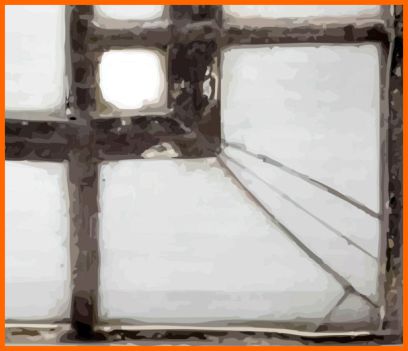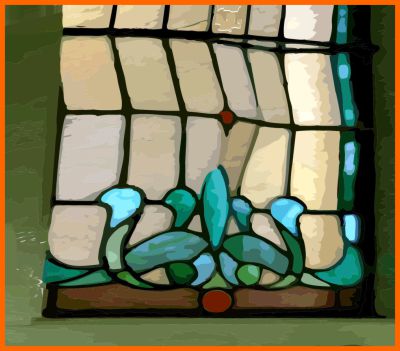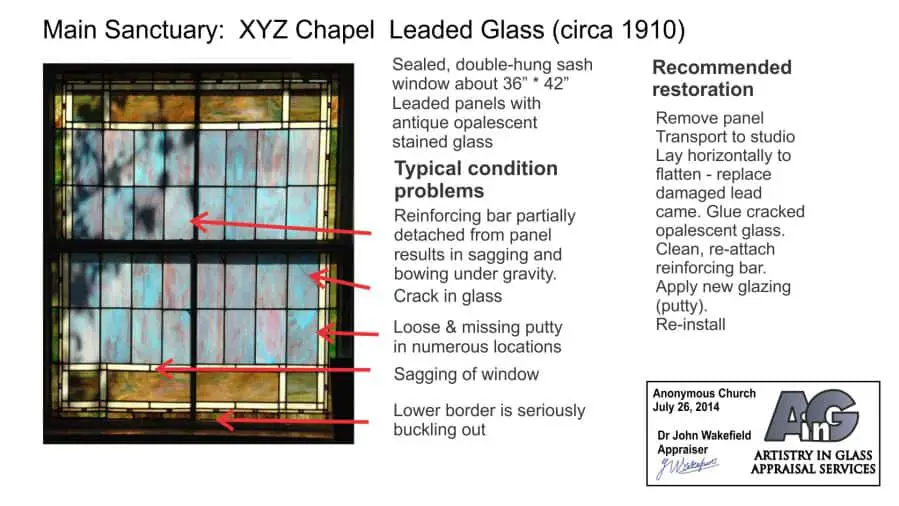If you’re lucky enough to have stained glass windows in your home, then you know just how beautiful they can be. But keeping them looking their best requires a bit of work. In this post, we’ll show you how to care for and clean stained glass windows so that they always look stunning. Keep reading to learn more!
Stained-glass windows are beautiful but fragile, so they require special care.
Dust, then clean stained glass with a soft cloth moistened with distilled water. Never use abrasive pads, steel wool, or strong chemicals like ammonia or acid.
If you have purchased an antique panel or are restoring older historic windows, they may be very grimey – in this case more serious cleaning will be necessary – read on to learn the process:
Table of contents
Don’t just jump in and start scrubbing away.
Take care, examine the stained glass and follow this advice:
- As a safety precaution, jump to this important info on the dangers of lead poisoning before starting any cleaning project.
- Examine the glass panel or hanging for signs of damage.
- If there are broken or missing pieces or if the windows have sagged and buckled – call an expert for professional advice.
- Use your best judgment to identify the glass – if it is antique and specially painted like a religious window – proceed with great care – cleaning is best left to an expert.
- If the panel is very dirty or weatherbeaten jump to this section.
- if the panel or lampshade is merely dusty and dull – follow the “Simple care and cleaning” instructions below:
As an Amazon Associate, I earn from qualifying purchases
For excellent cleaning hacks for your home follow this link to Porch,com
Simple care and cleaning
In most modern homes, stained glass windows are not used in the old-fashioned way – to keep the weather out. Instead, they are installed on the inside and thus protected from the elements.
Interior windows, hanging panels, sun-catchers, and stained glass lampshades, therefore, get dirty simply by collecting dust.
For panels like these the Stained Glass Association of America recommends:
- Use a duster and, if necessary, wipe clean with a soft, moist cloth.
- Use distilled water or rubbing alcohol because hard water may leave water spots.
- For more stubborn dirt add PH-neutral dish soap and use a Q-tip or cotton buds.
- Take special care with delicate suncatchers!
- Don’t spray water directly on the glass – it may leak through the metal cames and drip down on the interior.
- Don’t use Scotch pads, steel wool, or other abrasive cleaners, and don’t use strong chemicals like ammonia or acid.
Finish by polishing
Polishing with high-quality carnauba wax polish will shine up your glass and protect the metal from tarnishing.
E.J. Wheaton Glass wax is our recommendation for protecting and polishing your leaded glass. Adding a protective coat of carnauba wax will also protect your family against lead poisoning.
Serious cleaning
If you have inherited a Victorian transom window or purchased one at a yard sale, it may be time to do some serious cleaning. Many old panels are not only very dirty but also have layers of paint that was sloshed on when painting the frame.
Use common sense when cleaning – always test solvents on a small inconspicuous area!
Paint removal
Remember that part of the attraction of this genre of panels is the “shabby-chic” vibe. Frames with peeling paint are highly desirable so your job is often just to clean the excess paint off the glass.
Most paint strippers are safe to use on glass (but test to be sure). Apply the stripper then use a nylon brush to get into the corners. Flush and clean with water and dry before proceeding. (Remember to use gloves and safety goggles).
Complete the removal of grime from textured glass with soapy water and an old toothbrush.
Restore the loose putty
In order to stabilize and strengthen the panel, it may be necessary to replace missing putty.
If your old panels have loose putty – scrape out the dry stuff and replace it with new to stabilize and strengthen the panel.
We like this black putty available on Amazon. Follow the instructions to let the putty dry and clean thoroughly before going on to restore the lead.
Note to the lazy: if the panel appears solid and it is no longer required to be weather-proof – this re-puttying step may not be essential.
Restore the lead came
Traditional lead came looks best when it has a dark gray to black surface finish and your vigorous scrubbing and paint stripping will very likely have removed this “patina”.
In brief, you will need to prepare the lead (zinc or copper) by getting down to the metal with steel wool. Then you can have fun applying the patina and seeing the amazing results. Read posts like this for full instructions.
Maintaining the frame
A basic step for custodians of church, and other large windows is to carefully examine the wooden, metal, or masonry frame for evidence of deterioration. The window is only as strong as the attachment to the building so check that the support bars are still securely attached.
Minor repairs can easily be carried out by a competent handyman or woman.
Wax and polish
Finish the process by waxing with carnauba wax.
The images before show before and after shots of an Art Nouveau transom restored by Artistry in Glass


The removal of a century of grime completely revitalized this beautiful panel. Dirt was gently removed from crevices in textured “granite” glass with a toothbrush, soap and water. Missing pieces of blue border glass were replaced.
Damage to stained glass
Stained glass is unusually vulnerable to damage. The three main sources of problems are:
Broken, cracked, or missing glass
Glass, which is brittle, is easily broken by impacts with large objects or as a result of faulty design.

The cracks in this Frank Lloyd Wright panel are examples of unwise fabrication – the sharp “inside” angle in the corner glass is especially vulnerable to cracking. It is interesting to imagine that the great architect, embued with the arrogance and certainty of youth, overruled the glaziers and insisted on this dangerous design in what were his very first Prairie-style windows (made in 1900).
Artistry in Glass recommends preserving cracked antique glass whenever possible and stabilizing the cracks with optically clear, UV adhesive. This preserves the authenticity of the panel – contact John at [email protected] for more info.
Serious cracks and missing pieces really need the expertise of professionals like Artistry in Glass.
Buckled or sagging lead
Lead is ductile and easily bent out of shape if not correctly reinforced.

Horizontal steel rebar is traditionally used to reinforce stained glass in large panels. The rebar is keyed into the masonry or wooden frame to support the lead came and prevent it from sagging down under gravity.
Carefully check for sagging – it occurs gradually and progressively as the lead is heated and cooled by the weather. If not caught in time, the whole window can disintegrate making restoration cost-prohibitive.
Consult a professional immediately if you see signs of buckling or sagging.
Loose or missing putty
Putty is brushed and “squidged” into & under the came to stabilize and weatherproof the window. Putty has a limited (100-year) life and will dry out and detach with time.
The loss of putty further weakens a stained glass panel and contributes to sagging and buckling.
With serious damage of this type, the best procedure is to hire a professional stained glass company to perform an appraisal of the damage together with recommendations and cost estimates for restoration. They will provide a damage report similar to that shown below:

Note that putty is not used in “Tiffany-style” copper-foiled stained glass.
Study this interesting video to help you decide whether your damaged glass is worth fixing:
The danger of lead
Lead in the form of came (channel) or in solder is an important part of a stained glass panel and lead is poisonous.
The bottom line is that stained glass windows pose no threat to the homeowner provided simple precautions are taken. But, please read this informative post to learn all about the danger of lead in stained glass. In a companion post – this article explains the consequences of lead poisoning and the dangers of lead in crystal glassware.

Lead is a dangerous poison, especially for young children and pregnant mothers! Take great care to wash your hands thoroughly after any contact with lead.
Stained glass in religious settings
From early medieval times, stained glass windows have inspired congregations in the monumental Gothic cathedrals of Europe. Windows served not only as an illiterate man’s bible, allowing believers who could not read Latin to learn the story of the Gospels but also as man’s commitment to the creator – in praising the Lord with a sublime symphony of color worthy of God’s world – multicolored light as if projected from heaven itself.
Protecting stained glass in religious buildings
The high cost of repairing stained glass makes it extremely important to provide protection against damage caused by vandalism or bad weather. Read all about protective glazing in this post.

13th-century windows from Chartres Cathedral depict the stories of the Gospels. Do not attempt to clear or restore priceless stained glass unless you are an expert.
Study this comprehensive video to learn all about the care of liturgical stained glass:
In summary: take great care with valuable, painted glass you can easily do more harm than good!
In conclusion
If you have stained glass windows in your home and want to make sure they stay looking their best, follow these simple tips for cleaning and caring for them. And if you don’t have any stained glass windows but are considering adding some to your home, be sure to contact Artistry in Glass at 520-320-0104 – we would love to help! Study the amazing selection of articles listed below for all you need to know about stained glass.
All you need to know about art glass
Commissioning stained and etched glass
- Stained glass designs from Artistry in Glass
- How to commission a stained glass window – complete advice
- How to commission an etched glass window
- How to choose the best stained glass design
- Etched or stained glass – which is better for your home?
- How much does stained glass cost?
- How much does etched glass cost?
Technical information
- Is leaded glass dangerous? Learn the facts.
- How to replace broken patio table glass
- Plexiglass and glass – what are the pros and cons?
- What is plexiglass used for?
- What costs more – glass or plexiglass?
- Preservation of stained glass in churches & synagogues
- How does stained glass get colored? learn from an expert!
- Is your broken stained glass panel worth repairing?
- How to protect stained glass in religious buildings
- How to care for and clean stained glass
- How to repair cracked stained glass
- What is Dalle de Verre?
- How to repair Dalle de Verre
- What to do about bowed & sagging stained glass
- How to care for a stained glass skylight
- Can my stained glass lampshade be repaired?
- What is the difference between sandblasting & etching?
- Obscure and frosted glass – all you need to know!
- How to save money when buying glass
- Glossary of important terms used in decorative glass
- 14 Ways to sell stained glass
- What is imitation or faux stained glass?
Guides to stained glass design
- Guide for designing abstract stained glass
- Why choose abstract contemporary stained glass
- How to design a Frank Lloyd Wright-style window
- Designing a WWII-era stained glass Waco glider
- Stained glass and Black Lives Matter
- How Is stained glass used today?
Artistry in Glass was your source for antique repair in Tucson
Check out this amazing selection of informative articles:-
- Where can I get antiques repaired?
- Are broken antiques worth fixing?
- How to fix a broken picture frame
- How to repair a broken china plate
- How to repair a broken china teapot
- How to fix a broken marble slab
- How to repair a broken china coffee mug
- How to repair a 2000-year-old sculpture
- All about repairing stained-glass lampshades
- How to care for your stained glass skylight
- How to repair Dalle de Verre
- Is stained glass worth repairing?
- To repair or toss out?
- Tucson crystal & china repair a division of Artistry in Glass
- What to do with broken antiques
- Is lead crystal dangerous?
- Repairing an antique Mexican statue
- Repairing religious statues
- The history of Swarovski crystal figurines
- How to find the value of a Swarovski Crystal figurine
- Have Swarovski crystal figurines lost value since 2009?
- How to collect Swarovski annual ornaments
- How to display Swarovski crystal figurines
- How to authenticate a Swarovski crystal figurine
- How to display Swarovski annual ornaments
- How to clean Swarovski crystal figurines
- How to repair a Swarovski crystal mouse
- How to repair a Swarovski annual ornament
- How to repair a Swarovski crystal train set
- Fixing broken wine glass stems
- How to clean cloudy glasses
- Why do wine glasses have stems?
- Swarovski Crystal Figurines
- How to repair a chip in a wine glass
- How to fix a scratched glass tabletop
- How to replace a broken patio tabletop




